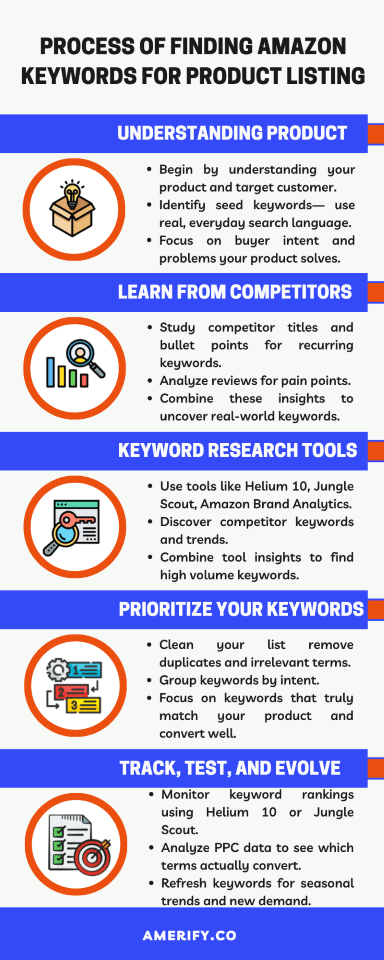Key Takeaways:
- Learning how to find: Learning how to find Amazon keywords helps shoppers find you faster and boosts your ranking potential.
- The best keyword strategies mix real customer insights with data from trusted tools.
- Keyword research isn’t one-and-done — track, test, and update regularly to stay competitive.
Why Learning How to Find Amazon Keywords Matters?
Every sale on Amazon starts with a search.
A customer types “insulated water bottle,” and Amazon’s algorithm (A9/A10) decides which listings show up.
If your product doesn’t use the right keywords, it’s invisible — no matter how great your reviews or price are.
That’s why learning how to find Amazon keywords is one of the most powerful skills every seller can master.
It’s the foundation of visibility, ranking, and ultimately — conversion.
Process of Finding Amazon Keywords for Product Listing

Step 1: Start With What You Know
Before you open any keyword research tool, start by understanding your own product and your customer.
Define Your “Seed Keywords”
Seed keywords are your starting point — the simplest phrases that describe your product.
For example, if you sell a stainless steel water bottle, your seed keywords could be:
- “insulated water bottle”
- “stainless steel flask”
- “metal gym bottle”
These will be the base for discovering more specific, high-intent search terms.
Think Like a Customer
Ask yourself:
- What would someone search if they were ready to buy this product?
- What problem are they trying to solve?
- Which words would they actually use — not the technical ones you’d use as a seller?
This mindset helps uncover natural, human search terms that keyword tools often miss.
Step 2: Use Amazon to Discover Real Search Behavior
The easiest way to learn how to find Amazon keywords is by letting Amazon show them to you.
When you start typing your seed keyword in the Amazon search bar, Amazon automatically suggests related searches. These aren’t random — they come directly from real customer data.
Example:
Typing “insulated water bottle” may suggest:
- “insulated water bottle 1 liter”
- “kids insulated bottle”
- “gym insulated bottle with straw”
Each suggestion represents real shopper demand.
Pro Tip: Add spaces or underscores before or after your keyword (“_ insulated bottle” or “insulated bottle _”) to discover more variations Amazon hides deeper in the algorithm.
Step 3: Learn From Your Competitors
Your competitors already rank for valuable keywords — and studying them is one of the smartest ways to find out which ones matter most.
Here’s how to reverse-engineer what works:
- Analyze competitor titles and bullets. Notice which phrases appear repeatedly (e.g. “leakproof,” “BPA-free,” “wide mouth”).
- Read customer reviews. Look for common pain points or benefits mentioned by buyers — those are keyword gold.
- Check Q&A sections. You’ll often find natural search terms that real shoppers use in their questions.
This combination of observation and empathy reveals insights no tool alone can give.
Step 4: Expand Using Keyword Research Tools
Once you’ve built a strong foundation, use data tools to scale your research.
Here’s how to find Amazon keywords using the best mix of tools:
- Helium 10 – Run a Reverse ASIN search to see which keywords your competitors already rank for organically.
- Jungle Scout – Great for search volume, keyword trends, and competitive difficulty.
- Amazon Brand Analytics – If you’re brand-registered, this gives you direct Amazon search term data.
- KeywordTool.io (Amazon Mode) – Generates hundreds of keyword variations based on actual Amazon searches.
Each tool has its strengths — but the real power comes from combining insights to find keywords that are both high-volume and highly relevant.
Step 5: Organize and Prioritize Your Keywords
By now, you’ll have a long list of keyword ideas. The next step is to turn that list into a focused strategy.
Clean Your Data
Remove duplicates, irrelevant words, and overly broad phrases.
Group by Intent
- Primary Keywords: High-traffic, general phrases (e.g. “insulated water bottle”).
- Long-Tail Keywords: More specific searches with buyer intent (e.g. “1L leakproof insulated bottle”).
- Feature Keywords: Focused on benefits or materials (“BPA-free,” “double wall,” “no sweat”).
Choose Keywords That Convert
Remember — not every popular keyword drives sales.
Focus on terms that match your exact product and buyer mindset.
Step 6: Place Keywords Strategically in Your Listing
Knowing how to find Amazon keywords is only half the equation — you need to know where to place them for maximum impact.
| Listing Section | What to Include? | Why It Matters? |
| Title | Your top 2–3 main keywords | The title has the strongest ranking power. |
| Bullet Points | Long-tail and benefit-based keywords | Improve visibility and conversion. |
| Description / A+ Content | Context-rich terms | Adds depth and supports indexing. |
| Backend Search Terms | Synonyms, misspellings, extra relevant phrases | Expands your search coverage. |
Example Title:
YourBrand 1L Insulated Stainless Steel Water Bottle – Leakproof, Keeps Drinks Cold 24h, Fits Bike Cage (No-Sweat Exterior)
This is keyword-optimized, but still natural and readable — exactly how Amazon prefers it.
Step 7: Track, Test, and Evolve
Once your keywords are live, the real work begins.
- Track Rankings: Use Helium 10 or Jungle Scout to monitor where you rank for your top keywords.
- Leverage PPC Data: Amazon ads reveal which search terms actually convert. Use that data to refine your organic listing.
- Refresh Regularly: Update your keywords seasonally (“summer,” “holiday gift”) or when new search trends emerge.
Mastering how to find Amazon keywords isn’t just about research — it’s about continuous learning and refinement.
Common Keyword Mistakes to Avoid
- Keyword Stuffing: Don’t cram every term into your title or bullets. It hurts readability.
- Ignoring Backend Keywords: You get 250 bytes of hidden space — use it wisely.
- Chasing Irrelevant Traffic: Ranking for the wrong keyword = clicks without conversions.
- Never Updating: Keyword trends shift constantly. Keep your research fresh.
Final Thoughts
Understanding how to find Amazon keywords gives you a real advantage — it’s the difference between being buried on page 5 and ranking on page 1.
When you take the time to research how shoppers think, organize your findings, and update your strategy regularly, your listings don’t just get seen — they get chosen.
At Amerify, we’ve helped countless sellers unlock growth just by refining their keyword strategy. Because on Amazon, visibility is everything — and it all starts with the right words.



